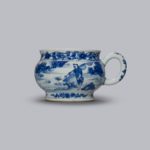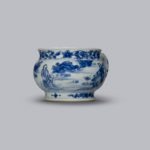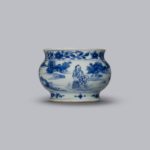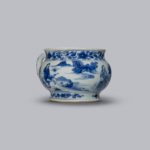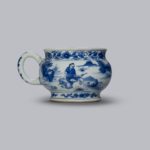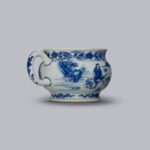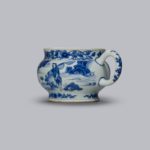
Chamber Pot [Ch218]
Jingdezhen, Jiangxi Province; Ming Dynasty, Chongzhen period, c. 1635-40
Porcelain with underglaze blue decoration (H. 11.5 cm)
Chamber pots were one of the first shapes made by Chinese potters specifically for export to Europe, and this piece must be among the earliest surviving examples. Only one other piece with this pattern is known (private collection, USA).
The chamber pot is painted in a style known as ‘transitional’, which spanned the last few decades of the Ming dynasty (1368-1644) and the beginning of the Qing dynasty (1644-1912). During the reigns of the Tianqi (1620-1627) and Chongzhen (1627-1644) emperors, the production of imperial porcelain at Jingdezhen ground to a halt, but enormous quantities of wares were produced by private kilns, many of them intended for the European market. The decoration of these late Ming wares was innovative in various ways. Artists used washes and layering to create effects similar to those of scroll paintings. There was an emphasis on naturalistic landscapes and narrative subjects, often painted in a continuous scene around the body of a vessel. This chamber pot is painted with figures in a river landscape: one fisherman carries a net over his shoulder and another holds a fish trap, while a third man sits on rocks holding an opium pipe.
Exhibited: ‘China without Dragons: Rare Pieces from Oriental Ceramic Society Members’, Sotheby’s, London, 3-9 November 2016, no. 131
Literature: Regina Krahl, China without Dragons: Rare Pieces from Oriental Ceramic Society Members (2018), p. 222
Provenance: Christie’s, London, 29 March 1982, lot. 3; accepted in lieu of Inheritance tax by HM Government from the estate of Anthony du Boulay in 2024 and allocated to the Winchester College Treasury Museum.
Location: Treasury, Gallery 2
